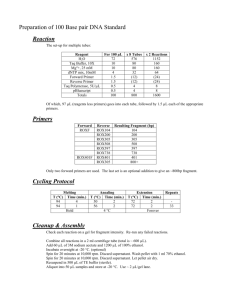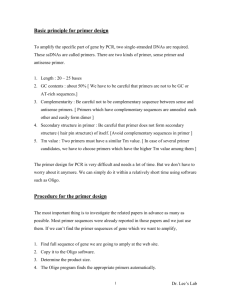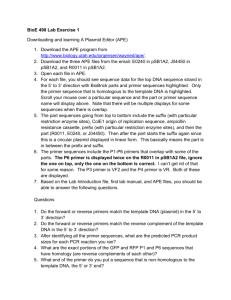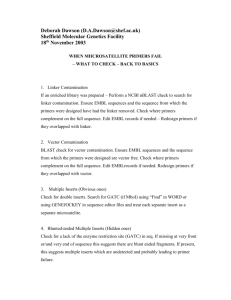Phaeocollybia Final Report to the Interagency Special Status/Sensitive Species Program
advertisement
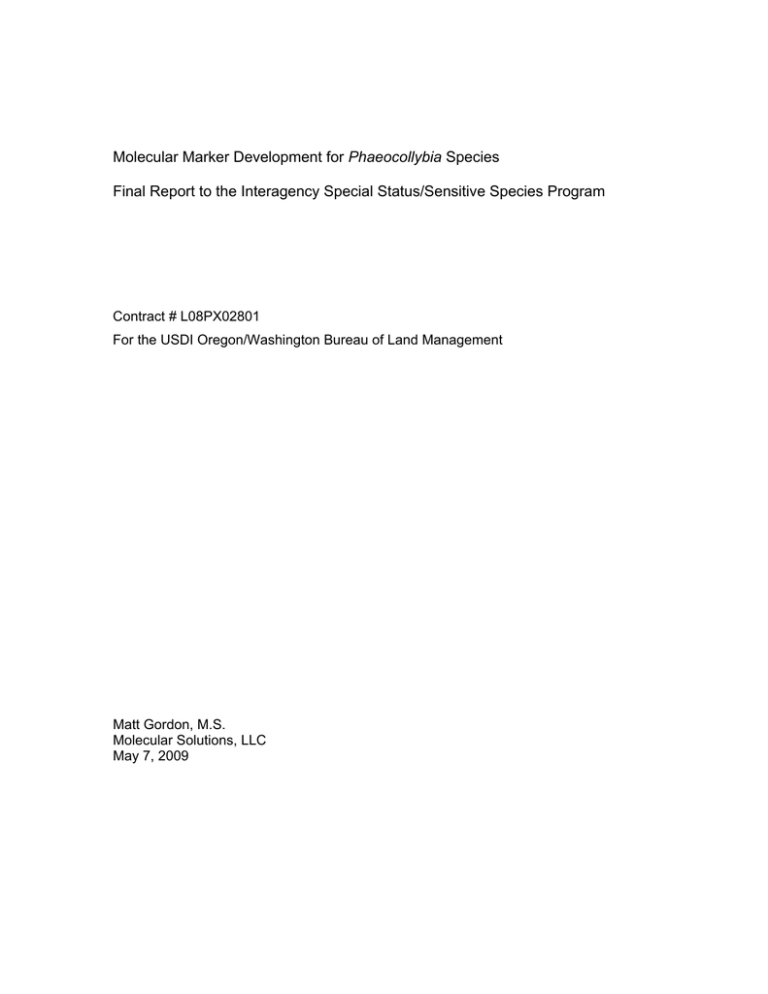
Molecular Marker Development for Phaeocollybia Species Final Report to the Interagency Special Status/Sensitive Species Program Contract # L08PX02801 For the USDI Oregon/Washington Bureau of Land Management Matt Gordon, M.S. Molecular Solutions, LLC May 7, 2009 Introduction Species-specific molecular markers can be used to detect fungal species in soil when no sporocarp is present. In this paper the term molecular marker will be used to describe segments of DNA of a specific size, that are amplified in a PCR (polymerase chain reaction), and visualized on an agarose gel that separates DNA fragments by size. Species-specific primers are used in the PCR to generate the species-specific markers. Primers are short segments of DNA (oligonucleotides) that can bind to DNA in a sample, for example from DNA extracted from soil, when a segment of the DNA in the sample exactly matches the sequence of the primer. By binding to the DNA, the primer creates a starting point for replication to occur in PCR. A second primer downstream from the first primer creates a starting point for replication in the opposite direction. Together the two primers define a segment of DNA of a specific length. If one or both of the primers is targeted to a DNA sequence that is unique to one particular species, it is a species-specific set of primers. If the DNA of the target species is present in a PCR with the species-specific primer, a marker of the specific length will be generated in the PCR. This species-specific marker will be seen when the products of the reaction are separated by size in an agarose gel. In order to facilitate the detection of Phaeocollybia species in areas of interest, the Interagency Special Status/Sensitive Species Program (ISSSSP) of the OR/WA BLM and Region 6 Forest Service contracted for the development of four species-specific molecular markers for four species of Phaeocollybia that are on the sensitive species list for Oregon. In order to target unique DNA segments with species-specific primers, it is essential to have knowledge of the genetic sequence of the target species and of all closely related species. The internally transcribed spacer (ITS) region of the gene that codes for ribosomal RNA in fungi has long been targeted for the development of species-specific markers in fungi, because this region is variable, but typically remains consistent within species. A preliminary review of the ITS sequences of Phaeocollybia species available in GenBank indicated that there was good variation of this region between Phaeocollybia species, so this region was targeted for sequencing, with the idea of finding variable regions that could be used to design species-specific primers. This project had three phases: 1. Sequence the ITS region for up to ten collections of each of the 25 Phaeocollybia species found in the Pacific Northwest and align these sequences, and sequences in GenBank, to generate consensus sequences for each species. 2. Using these consensus sequences, design species-specific primers that generate markers of different sizes for four Phaeocollybia species. 1 3. Test these primer sets on representatives of all 25 Phaeocollybia species to confirm their effectiveness and specificity. Materials and Methods DNA was extracted from Phaeocollybia collections (Table I). Both recently collected material, in the possession of ISSSSP, and material in the collection of Dr. Lorelei Norvell was used (see Table III in the appendix). All ISSSSP Phaeocollybia collections had been identified to species by Dr. Norvell. DNA was extracted with a standard Chelex method. DNA was then run in a PCR with the primers ITS1 and ITS4b to amplify the ITS region of these fungi. Successfully amplified samples were submitted for sequencing to an outside lab (Functional Biosciences, Madison, WI). Both forward and reverse sequences were obtained for each sample. Forward and reverse sequences were aligned using the program Gap 4.10, and a single consensus sequence was determined for each sample. In general, most samples were sequenced and aligned without difficulty. However, some species (californica and rufotubulina) had a region of repeating A’s, and some species (kauffmanii and redheadii) had a region of repetitive A’s and T’s. These repetitive A/T regions are difficult to sequence. Some success was obtained by re-doing the PCR step for failed samples with a lower extension temperature, and submitting these amplicons for sequencing. The 148 Phaeocollybia sequences obtained in this project were pooled with 74 Phaeocollybia ITS sequences available in GenBank to form a collection of ITS sequences from 222 Pacific Northwest Phaeocollybia collections. All of the individual sequences for each species were aligned and a consensus sequence was generated for each species using the program Clustal X. Groupings of taxa based on ITS sequence similarity differed in some cases from the sample names. This issue is discussed in the Results section. All species’ consensus sequences were then aligned and a phylogenetic tree was generated for the entire genus using Geneious Pro 4.6.4. Geneious Tree Builder, a neighbor joining tree building method was used with a Tamura-Nei Genetic Distance Model. Bootstrap resampling was used with 250 samples. The support threshold for branches was set at 50%. Consensus sequences for each species were compared using Geneious Pro 4.6.4. The species P. californica, P. scatesiae, P. sipei, and P. spadicea were chosen as the target species for this study. Genetic regions within the ITS region of these species were identified, and primers were designed to target these variable regions, so that each primer would bind only to one target species. 2 Table I. List of the 25 Phaeocollybia fungal species that occur in the Pacific Northwest, species abbreviations, and the 2008 ISSSSP species status. Species Name Species Abbreviation ISSSSP species status* Phaeocollybia ammiratii amm Phaeocollybia attenuata att SEN (FS ONLY) Phaeocollybia benzokauffmanii ben None Phaeocollybia californica cal OR-SEN Phaeocollybia dissiliens dis OR-SEN Phaeocollybia fallax fal None WA-SEN (FS ONLY) Phaeocollybia gregaria gre OR-SEN Phaeocollybia kauffmanii kau None Phaeocollybia lilacifolia lil OR-STR Phaeocollybia luteosquamulosa lut None Phaeocollybia ochraceocana och None Phaeocollybia olivacea oli OR-SEN Phaeocollybia oregonensis ore SEN Phaeocollybia phaeogaleroides pha None Phaeocollybia piceae pic SEN (FS ONLY) Phaeocollybia pleurocystidiata ple None Phaeocollybia pseudofestiva pse SEN Phaeocollybia radicata rad OR-STR Phaeocollybia redheadii red None Phaeocollybia rifflipes rif None Phaeocollybia rufotubulina ruf OR-STR Phaeocollybia scatesiae sca SEN Phaeocollybia sipei sip OR-SEN Phaeocollybia spadicea spa SEN Phaeocollybia tibiikauffmanii tib None * = SEN is sensitive, STR is strategic, OR is Oregon, WA is Washington, FS is Forest Service Primers were selected manually and tested in silico using the free programs BioMath and IDT OligoAnalyzer 3.1. Two or three potential forward primers for each species were then tested in PCRs with DNA from representatives of the four target species and species closely related to the target species. A set of primers (4 forward primers and 2 reverse primers) that was specific 3 and yielded products of different sizes for each of the four target species was developed through this testing. These primers were then tested on DNA from all available collections of the target species, and with two representatives of each non-target Phaeocollybia species present in the Pacific Northwest to confirm their effectiveness as species-specific primers for P. californica, P. scatesiae, P. sipei, and P. spadicea. Results Sequencing and Alignment The source material identification information or the GenBank accession number of all sequences used in this project are shown in Table III (Appendix). A total of 222 individual samples of the 25 Phaeocollybia species present in the Pacific Northwest were used. After sequence alignment by species, it was clear that some species contained two subgroups with significant sequence differences between them. For example, Figure 1 shows an alignment of a portion of the available sequences for tibiikauffmanii. In this depiction, loci where all sequences agree with each other are shown with a white background, while areas of disagreement are shown with a colored background. Figure 1. Alignment of a portion of the ITS1 region of 8 tibiikauffmanii collections There are quite a few base discrepancies in the region shown, but the top 6 collections are identical to each other, and the bottom 2 collections are nearly identical, but different than the upper group. In cases like this, the species group was split. The larger subgroup was labeled with the suffix “ _A”, and the smaller subgroup with the suffix “_B”, and a unique consensus was generated for each subgroup. Each subgroup consensus was run in the subsequent analysis as if it were an independent species. Figure 2 is the phylogenetic tree generated using consensus sequences from each of the 25 Pacific Northwest Phaeocollybia species and species subgroups. Preliminary tree-building trials consistently showed P. radicata to be basal to the other species, so it was set as the outgroup in the tree shown in Figure 2. In this figure, three letter codes (the first three letters of 4 the species name) are used to identify species. These codes are listed in Table I, and may be used to refer to species elsewhere in this document. In all cases, the two subgroups of a split species came out on distinctly different branches of the genus tree, indicating that the differences between the subgroups of these split species was as great as the differences between accepted species. The tree also shows some species and subgroups clustering at the tips of some branches, indicating that some of these taxa may be the same species. This issue will be discussed further below with regard to the cluster of species containing P. spadicea and cluster containing P. californica. 5 Figure 2. Phylogenetic tree for the genus Phaeocollybia based on ITS sequences. Branch consensus support (%) is shown. P. radicata is the outgroup. Taxa targeted in this study are shown in shaded boxes. 6 Molecular Marker Development In this project, molecular marker development was focused on the rare species: P. californica, P. olivacea, P. pseudofestiva, P. scatesiae, P. sipei, and P. spadicea, with the goal of developing specific primers capable of detecting at least four of these species. The genus tree shows that californica sequences cluster with rufotubulina and pse_B. An alignment of all 17 sequences from samples in these three groups showed that there was little difference between them (pairwise identity = 99.3%), and they were collapsed together into “californica group” or cal_group. As a comparison, the pairwise identity between the pic_A and sca consensus sequences is 90.1%, and the pairwise identity between the closely related lut and och sequences is 95.7%. Figure 3 shows a phylogenetic tree for the californica group based on the ITS sequences, with pleurocystidiata as an outgroup. The short branch lengths for the individuals in this group show that they are all closely related. The sample pse_B_EU669240 appears to be somewhat out of the main grouping, but this is because the sequence quality for this sample was not as good as the others, and there were several ambiguous bases reported in the sequence. The ambiguous bases are all consistent with the other sequences in this group. 7 Figure 3. Phylogenetic tree for cal_group samples with pleurocystidiata as the outgroup. A similar situation was found for spadicea, tib_A, and pse_A, which formed “spadicea group” or spa_group. The pairwise identity for this group of 18 sequences is 99.9%. The consensus tree, with gregaria as the outgroup, is shown in Figure 4. 8 Figure 4. Phylogenetic tree for spa_group samples with gregaria as the outgroup. Although cal_group and spa_group each incorporated all or part of three species, there were distinct differences between these groups and all other taxa on the tree. So along with sipei and scatesiae, cal_group and spa_group were chosen as target species for marker development. The four consensus sequences for these target species were aligned, and the sequences inspected for variable areas. As discussed in the Introduction, two primers, an upstream or “forward” primer and a downstream or “reverse” primer are needed to produce a species-specific marker in PCR. Much inter-species variability was seen in the 5’ or upstream part of the ITS sequences, where the forward primer bonds. It was decided to design a common reverse primer, and use the 5’ variability to design 4 unique forward primers. A non-specific primer such as ITS4 or ITS4b could be used as a reverse primer, but a unique reverse primer was designed to enhance the specificity of the primer set. The 3’ or downstream part of these sequences and other sequences in the genus were compared and a reverse primer was designed based on a region that was unique to the four target species and a few other Phaeocollybias. The region was not present in two other genera in the Cortinariaceae family. 9 The P. sipei sequence had minor non-homologies with the group reverse primer (gr_1r), so a second reverse primer (gr_2r), corresponding to the same region but specific to P. sipei, was designed and tested. In initial testing, the gr_1r primer worked fine on P. sipei samples, indicating that the sequence differences are not consequential. However, final testing was done with both primers gr_1r and gr_2r in all PCR reaction mixes. Further testing may indicate that primer gr_2r is not needed. Candidate forward primers for the four target species were tested in PCRs with the two reverse primers, and a group of four compatible forward primers was developed (Table II). Table II. Species-specific primers developed in this study. Primer names ending in f are forward primers, and names ending in r are reverse primers. Primer Name cal_1f Target Sequence Product Size californica group GAACTCATTTATTCCTCGAGTATTTCTC 382 sca_1f scatesiae AGACAAGAAAGAAAAAGGGATTTATTCCTT 423 sip_3f sipei GTGGTTGTAGCTGGCAGTTTA 503 spa_8f spadicea group GAGTGTCATTAAATTATCAAAAAAAGATCTTC 131 gr_1r all four spp. GATAATTATCACACCAATAGACAAAGTC gr_2r sipei GATAATTATCACACCAAATAGACCAAGTC Running a PCR with more than one primer set and targeting more than one sequence in the same reaction is referred to as multiplex PCR. Figure 5 shows the results of multiplex PCR using all of the primers in Table II with Phaeocollybia DNA. In this gel, lanes 5 and 22 contained P. scatesiae DNA, lanes 8 and 9 contained pse_A (spa group) DNA, lanes 16 and 17 contained tib_A (spa group) DNA, lane 10 contained tib_B (cal group) DNA, lane 18 contains rufotubulina (cal group) DNA, lanes 19, 20, 21, and 23 contain californica DNA, and lanes 24 and 26 contain sipei DNA. All of these were strongly positive with a product of the expected size for the species present in the reaction, except for lanes 18 and 19. The DNA in each of these lanes came from collections that had been made in 1956, and were not expected to show significant amplification. Other species represented on this gel are phaeogaleroides, piceae, pleurocystidiata, radicata, redheadii, rifflipes, and fallax. All of these non-target DNA samples were negative in reactions that contained all of the primers in Table II. 10 1 2 3 4 5 6 7 8 9 10 11 12 13 14 15 16 17 18 19 20 21 22 23 24 25 26 27 500 bp 300 bp 100 bp Figure 5. Gel of PCR products from reactions of Phaeocollybia DNA with reactions containing all primers in Table I. See text for identities of species tested. Final Testing The final testing plan was to test all available DNA samples in the four target species, and to test two samples from each of the non-target species. Some Phaeocollybia DNA samples were available from a previous project, so some extra target species samples were drawn from that collection for testing in this project. The results of all testing are shown in Table IV. 11 Table IV. Results of testing Phaeocollybia DNA with specific primers. Test Id. 90414_13 90414_14 90416_13 90408_7 90418_29 90418_30 90414_15 90414_16 90410_1 90418_19 90418_20 90418_21 90418_23 90407_8 90407_9 90416_14 90418_27 90418_28 90414_17 90414_18 90416_20 90414_25 90414_26 90414_23 90414_24 90410_9 90410_10 90414_27 90414_28 90410_6 90416_21 90410_7 90416_19 90416_22 90418_1 90418_2 90418_3 90418_4 90418_6 90418_7 90418_9 90418_8 90416_10 90418_10 90418_11 90418_12 90418_14 Species amm amm att att att att ben ben cal cal cal cal cal dis dis dis fal_A fal_B gre gre gre kau kau lil lil lut lut och och oli oli oli ore ore pha_A pha_B pic_A pic_A ple ple pse_A pse_A pse_A pse_B rad rad red Sample # r001 r017 r030 r031 r033 r034 r025 r048 r009 r041 r058 r059 r060 r013 r092 r093 p329 p327 r090 r121 r123 r169 r179 r012 r113 r136 r144 r004 r146 r125 r126 r150 r089 r132 r105 r112 r035 r039 r064 r087 p371 p372 r178 p369 r114 r115 r003 Result + + + + + + + + - 12 Test Id. 90418_13 90418_15 90408_2 90416_1 90416_2 90416_3 90418_18 90416_4 90416_5 90414_7 90414_1 90414_2 90414_3 90414_22 90418_22 90416_15 90416_16 90416_17 90416_18 90414_20 90418_24 90418_25 90414_21 90418_26 90414_12 90410_15 90408_1 90416_9 90407_11 90418_16 90414_8 90414_9 90414_10 90418_17 90414_11 90416_6 Species red rif ruf ruf ruf ruf ruf ruf ruf ruf sca sca sca sca sca sca sca sca sca sip sip sip sip sip sip sip spa spa tib_A tib_A tib_A tib_A tib_A tib_A tib_B tib_B Sample # r085 r010 r073 r074 r075 r076 r077 r078 r079 r080 p275 p276 p280 r081 r096 r098 r099 r100 r101 p355 p359 p360 p362 p363 r134 r135 r161 r177 r153 r154 r155 r156 r157 r159 r158 r152 Result + + + + + wk + + + + + + + + + + + + + + + + + + + + + + + + + - A total of 81 non-target samples were tested, and all of them came out negative. A total of 41 target species samples were tested, 38 of them were positive and 3,were negative (shown in red in Table IV). Two of them, a californica (r041) and a rufotubulina (r077) collection, were discussed above. They were DNA from 50+ year old collections that were only weakly positive when tested with ITS primers. The third negative, a scatesiae (r099) was from a 16 year old collection, and again had only given a weak positive response with ITS primers. I believe that 13 these three failures were due to poor DNA condition in the sample and did not indicate a failure of the primers. Conclusion Four species-specific primer sets were developed, for P. californica, P. scatesiae, P. sipei, and P. spadicea. Each of these primer sets amplifies a marker of a different size when its target species is present. These four primer sets can be used in one multiplex PCR to test for all four species simultaneously. The primers were tested against representatives of all known Phaeocollybia species present in the Pacific Northwest and were found to be specific to their target species. As a practical test of these primers, it would be useful to test soil samples known to contain the target species. One way to accomplish this is to spike soil samples with a known amount of target species tissue from a sporocarp. Soil samples with different levels of sporocarp tissue could be tested to quantify the sensitivity of the method. 14 Appendix Table III. Phaeocollybia collections whose ITS sequences were used in this study. Samples with a project number were extracted, amplified and sequenced in this study. Others were taken from nd GenBank. GenBank reference numbers (all beginning “EU…”) are given in the 2 column, otherwise the collection reference number is given. Project Number Reference Species r001 TJR F13F r007 TJR F13D ammiratii ammiratii r014 RLE 2007 105 ammiratii r015 RLE 2007 117 ammiratii r023 RLE 2007 042 ammiratii r024 RLE 2007 036 ammiratii r016 RLE 2007 161 ammiratii r017 RLE 2007 032 ammiratii r018 RLE 2007 103 ammiratii r019 LLN 2071029-25 ammiratii r020 LLN 51018-1 ammiratii r030 RLE 2007 176 attenuata r031 LN 207 1018-11 attenuata r032 RLE 2002 42 attenuata r033 RLE 2007 144 attenuata r034 RLE 2007 162 attenuata EU697254 attenuata EU846287 attenuata EU846288 attenuata EU846289 attenuata EU846290 attenuata EU846291 attenuata r022 LLN 92.11.20-1 benzokauffmanii r025 a2061114o1I benzokauffmanii r026 RLE 2007 018 benzokauffmanii r027 A2001101O1-01 benzokauffmanii r028 LLN2071018-06 benzokauffmanii r029 RLE 2007 147 benzokauffmanii r047 RLE 2007 150 benzokauffmanii r048 RLE 2007 035 benzokauffmanii r049 RLE 2007 075 benzokauffmanii r021 LLN 92.10.23-1 ben2) benzokauffmanii r009 F7 JS 39 californica r058 RLE 2007 135 californica r059 RLE 2007 138 californica r060 RLE 2007 177 californica EU846293 californica EU846292 californica EU669238 californica 15 Project Number Reference EU669237 Species californica EU681187 californica r013 F7 JS 19 dissiliens r092 RLE 2007 169 dissiliens r093 RLE 2008 138 dissiliens EU846273 dissiliens EU846272 dissiliens EU846271 dissiliens EU669357 dissiliens EU669356 dissiliens EU669355 dissiliens EU669354 dissiliens EU846286 fallax EU846285 fallax EU846284 fallax EU846283 fallax EU846282 fallax EU846281 fallax EU669366 fallax EU669338 fallax EU669312 fallax EU697253 fallax r116 RLE 2007 59 gregaria r117 RLE 2007 104 gregaria r118 RLE 2007 049 gregaria r119 RLE 2006 06 gregaria r120 RLE 2007 019 gregaria r090 CH2 JP8 gregaria r121 RLE 2007 061 gregaria r122 LLN 2071029-27 gregaria r123 RLE 2008 26 gregaria r124 RLE 2007 121 gregaria r002 TJR F10 kauffmanii r088 W29 11/7/7 kauffmanii r164 RLE 2008-27 kauffmanii r165 RLE 2006-10 kauffmanii r167 LLN 92.11.24-12 kauffmanii r169 LLN 2001105-02 kauffmanii r012 F7 JS 18 lilacifolia r113 RLE 2008 47 b lilacifolia r040 LLN 207-1018-12 lilacifolia r042 RLE 2007 020 lilacifolia r043 RLE 2007 021 lilacifolia r044 LN 207 1018-13 lilacifolia r045 RLE 2007 022 lilacifolia 16 Project Number Reference r136 RLE 2007-016 luteosquamulosa r137 RLE 2007-125 luteosquamulosa r138 RLE 2007-051 luteosquamulosa r139 RLE 2007-050 luteosquamulosa r140 LLN2071029-43 luteosquamulosa r141 LLN2071029-33 luteosquamulosa r142 LLN2071029-24 luteosquamulosa r143 LLN2071029-46 luteosquamulosa r004 CH JP7 ochraceocana r005 30 V ochraceocana r146 RLE 2007-009 ochraceocana r147 RLE 2007-033 ochraceocana r148 RLE 2007-057 ochraceocana Species r125 GAL-JP2 (BLMOR110) olivacea r126 MCM2CN6 (BLMOR080) olivacea r150 RLE 2008-129 olivacea r151 LLN 92.11.22-4 olivacea EU846266 olivacea EU846265 olivacea EU846264 olivacea EU846263 olivacea EU669235 olivacea EU669234 olivacea r089 CH2 JP3 oregonensis r128 UEC 153 oregonensis r130 Ex198-101 oregonensis r131 RLE 2007-130 oregonensis r132 RLE 2006-16 oregonensis r127 LLN 2001105-01 oregonensis EU846274 oregonensis EU697251 oregonensis EU697250 oregonensis EU846273 oregonensis r103 RLE 2008 003 phaeogaleroides r105 LN 2071029-53 phaeogaleroides r106 LN 2071029-14 phaeogaleroides r107 RLE 1999-64 phaeogaleroides r108 RLE 2007 152 phaeogaleroides r109 LLN 2000426-01 phaeogaleroides r110 g2041122c2-1 phaeogaleroides r111 RLE 2007 93 phaeogaleroides r112 g2051026c1-6 phaeogaleroides r039 RLE 2007 027 piceae r035 RLE 2007 178 piceae 17 Project Number Reference r037 RLE 2007 143 r175 LLN 92.10.09-7 piceae EU846267 piceae EU697249 piceae EU846268 piceae EU669236 piceae Species piceae r086 MCM3 CN6 pleurocystidia r087 LIM3 JPS pleurocystidia r061 LLN 93.05.16-1 pleurocystidia r062 RLE 2008 002 pleurocystidia r063 LLN 94.03.30-2 pleurocystidia r064 RLE 2007-001 pleurocystidia r065 RLE 2005-002 pleurocystidia r066 4699SL pleurocystidia r068 4664SL pleurocystidia r069 RLE 2008 050 pseudofestiva r070 RLE 2007 164 pseudofestiva r178 F7-JS-38E-11/27/07 pseudofestiva EU846297 pseudofestiva EU852801 pseudofestiva EU669241 pseudofestiva EU669240 pseudofestiva EU669239 pseudofestiva EU697255 pseudofestiva r114 RLE 2008 131 radicata r115 RLE 2006 19 radicata r176 F7-JS-36-11/21/07 radicata EU846277 radicata EU846276 radicata EU846275 radicata EU669360 radicata EU669359 radicata EU669358 radicata EU669361 radicata r003 TJR F12 redheadii r082 07 TRJ F07C redheadii r181 07-TJR-F08 11/8/07 redheadii r083 07 TJR F11A redheadii r085 8 TJR F07A redheadii r170 RLE 2008-38 redheadii r172 LLN 95.10.18-18 redheadii r010 F7 JS 32 r091 4592 SL rifflipes r054 RLE 2006 043 rifflipes rifflipes 18 Project Number Reference r055 Ex 199- M rifflipes r057 A202 1113 O1-02 rifflipes r050 LLN 92.11.11-6 rifflipes r051 A 202 1204 O1-07 rifflipes r052 A 201 1031 Y1 rifflipes r053 A206 1114 O1e rifflipes r095 RLE 2008 44 rifflipes r078 LLN 97.10.31-1 rufotubulina r079 LLN 92.11.24-2 rufotubulina r073 LLN 92.11.16-1 rufotubulina r074 SAR 7500 rufotubulina r075 LLN 92.11.21-6 rufotubulina r076 LLN 92.11.17-8 rufotubulina r077 AHSmith 55611 rufotubulina r081 LLN 95.11.09-27b r096 LLN 95.11.09-27b scatesiae r098 RLE 2007 151 scatesiae r099 LLN 92.10.15-19 scatesiae r100 LLN 95.10.14-4 scatesiae r101 LLN 93.11.04-9 scatesiae EU846270 scatesiae r134 Species scatesiae EU846269 scatesiae EU669353 scatesiae EU669352 scatesiae RLE 2007-123 sipei EU846294 sipei EU846296 sipei EU846295 sipei EU644708 sipei EU644707 sipei EU644706 sipei EU644705 sipei r161 RLE 2007-141 spadicea r177 07-TJR-F02-10/25/07 spadicea EU846280 spadicea EU846279 spadicea EU669365 spadicea EU669364 spadicea EU669363 spadicea EU669362 spadicea EU697252 spadicea EU846278 spadicea r152 RLE2007-129 tibiikauffmanii r153 RLE 2008-55 tibiikauffmanii 19 Project Number Reference r154 RLE 2007-060 Species tibiikauffmanii r155 RLE 2007-165 tibiikauffmanii r156 Dcalver 200-13 tibiikauffmanii r157 a2061114o2-O tibiikauffmanii r158 RLE 2007-074 tibiikauffmanii r159 a2011031ox-01 tibiikauffmanii 20

